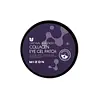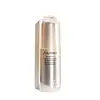What's inside
What's inside
 Key Ingredients
Key Ingredients

 Benefits
Benefits

 Concerns
Concerns

 Ingredients Side-by-side
Ingredients Side-by-side

Water
Skin ConditioningGlycerin
HumectantChondrus Crispus Extract
Skin ConditioningCeratonia Siliqua Gum
EmollientCellulose Gum
Emulsion StabilisingHydroxyacetophenone
Antioxidant1,2-Hexanediol
Skin ConditioningSucrose
HumectantPotassium Chloride
Allantoin
Skin ConditioningXanthan Gum
EmulsifyingEthylhexylglycerin
Skin ConditioningCalcium Aluminum Borosilicate
CI 77007
Cosmetic ColorantAdenosine
Skin ConditioningBis-PEG-15 Methyl Ether Dimethicone
EmulsifyingDisodium EDTA
Calcium Lactate
AstringentCI 77891
Cosmetic ColorantSilica
AbrasiveMica
Cosmetic ColorantHydrolyzed Collagen
EmollientDipotassium Glycyrrhizate
HumectantSodium Polyacryloyldimethyl Taurate
Emulsion StabilisingPolyglyceryl-4 Caprate
EmulsifyingPolyglyceryl-6 Caprylate
EmulsifyingDipalmitoyl Hydroxyproline
Skin ConditioningPEG-60 Hydrogenated Castor Oil
EmulsifyingButylene Glycol
HumectantPalmitic Acid
EmollientParfum
MaskingPortulaca Oleracea Extract
Skin ConditioningChamomilla Recutita Flower Extract
MaskingCaviar Extract
Skin ConditioningPhenoxyethanol
PreservativeTocopherol
AntioxidantWater, Glycerin, Chondrus Crispus Extract, Ceratonia Siliqua Gum, Cellulose Gum, Hydroxyacetophenone, 1,2-Hexanediol, Sucrose, Potassium Chloride, Allantoin, Xanthan Gum, Ethylhexylglycerin, Calcium Aluminum Borosilicate, CI 77007, Adenosine, Bis-PEG-15 Methyl Ether Dimethicone, Disodium EDTA, Calcium Lactate, CI 77891, Silica, Mica, Hydrolyzed Collagen, Dipotassium Glycyrrhizate, Sodium Polyacryloyldimethyl Taurate, Polyglyceryl-4 Caprate, Polyglyceryl-6 Caprylate, Dipalmitoyl Hydroxyproline, PEG-60 Hydrogenated Castor Oil, Butylene Glycol, Palmitic Acid, Parfum, Portulaca Oleracea Extract, Chamomilla Recutita Flower Extract, Caviar Extract, Phenoxyethanol, Tocopherol
Water
Skin ConditioningButylene Glycol
HumectantPentaerythrityl Tetraethylhexanoate
EmollientDimethicone
EmollientGlycerin
HumectantDipropylene Glycol
HumectantSd Alcohol 40-B
AstringentBehenyl Alcohol
EmollientSilica
AbrasivePEG-400
Emulsion StabilisingBatyl Alcohol
EmollientPhenoxyethanol
PreservativeMethylparaben
PreservativeCarbomer
Emulsion StabilisingDimethylacrylamide/Sodium Acryloyldimethyltaurate Crosspolymer
Trisodium EDTA
Tocopheryl Acetate
AntioxidantRetinyl Acetate
Skin ConditioningAlcohol
AntimicrobialHelianthus Annuus Seed Oil
EmollientBHT
AntioxidantPolyquaternium-51
Skin ConditioningParfum
MaskingPotassium Hydroxide
BufferingCaffeine
Skin ConditioningXanthan Gum
EmulsifyingAcrylates/C10-30 Alkyl Acrylate Crosspolymer
Emulsion StabilisingPPG-3 Dipivalate
Skin ConditioningRosa Canina Fruit Oil
EmollientCI 77492
Cosmetic ColorantTocopherol
AntioxidantSapindus Mukorossi Peel Extract
Skin ConditioningLinalool
PerfumingLimonene
PerfumingSodium Metabisulfite
AntioxidantTriisostearin
Skin ConditioningUncaria Gambir Extract
AstringentCitronellol
PerfumingAngelica Keiskei Leaf/Stem Extract
Skin ConditioningTrimethylolpropane Triethylhexanoate
EmollientGeraniol
PerfumingCellulose
AbsorbentCamellia Sinensis Leaf Extract
AntimicrobialSodium Acetylated Hyaluronate
HumectantHydroxyproline
Skin ConditioningZiziphus Jujuba Fruit Extract
Skin ConditioningChlorella Vulgaris Extract
Skin ConditioningMethicone
EmollientTetradecene
EmollientEucheuma Serra/Grateloupia Sparsa/Saccharina Angustata/Ulva Linza/Undaria Pinnatifida Extract
EmollientCurcuma Longa Rhizome Extract
Skin ConditioningSaccharina Angustata/Undaria Pinnatifida Extract
EmollientPanax Ginseng Root Extract
EmollientAscorbyl Dipalmitate
AntioxidantWater, Butylene Glycol, Pentaerythrityl Tetraethylhexanoate, Dimethicone, Glycerin, Dipropylene Glycol, Sd Alcohol 40-B, Behenyl Alcohol, Silica, PEG-400, Batyl Alcohol, Phenoxyethanol, Methylparaben, Carbomer, Dimethylacrylamide/Sodium Acryloyldimethyltaurate Crosspolymer, Trisodium EDTA, Tocopheryl Acetate, Retinyl Acetate, Alcohol, Helianthus Annuus Seed Oil, BHT, Polyquaternium-51, Parfum, Potassium Hydroxide, Caffeine, Xanthan Gum, Acrylates/C10-30 Alkyl Acrylate Crosspolymer, PPG-3 Dipivalate, Rosa Canina Fruit Oil, CI 77492, Tocopherol, Sapindus Mukorossi Peel Extract, Linalool, Limonene, Sodium Metabisulfite, Triisostearin, Uncaria Gambir Extract, Citronellol, Angelica Keiskei Leaf/Stem Extract, Trimethylolpropane Triethylhexanoate, Geraniol, Cellulose, Camellia Sinensis Leaf Extract, Sodium Acetylated Hyaluronate, Hydroxyproline, Ziziphus Jujuba Fruit Extract, Chlorella Vulgaris Extract, Methicone, Tetradecene, Eucheuma Serra/Grateloupia Sparsa/Saccharina Angustata/Ulva Linza/Undaria Pinnatifida Extract, Curcuma Longa Rhizome Extract, Saccharina Angustata/Undaria Pinnatifida Extract, Panax Ginseng Root Extract, Ascorbyl Dipalmitate
Ingredients Explained
These ingredients are found in both products.
Ingredients higher up in an ingredient list are typically present in a larger amount.
Butylene Glycol (or BG) is used within cosmetic products for a few different reasons:
Overall, Butylene Glycol is a safe and well-rounded ingredient that works well with other ingredients.
Though this ingredient works well with most skin types, some people with sensitive skin may experience a reaction such as allergic rashes, closed comedones, or itchiness.
Learn more about Butylene GlycolGlycerin is already naturally found in your skin. It helps moisturize and protect your skin.
A study from 2016 found glycerin to be more effective as a humectant than AHAs and hyaluronic acid.
As a humectant, it helps the skin stay hydrated by pulling moisture to your skin. The low molecular weight of glycerin allows it to pull moisture into the deeper layers of your skin.
Hydrated skin improves your skin barrier; Your skin barrier helps protect against irritants and bacteria.
Glycerin has also been found to have antimicrobial and antiviral properties. Due to these properties, glycerin is often used in wound and burn treatments.
In cosmetics, glycerin is usually derived from plants such as soybean or palm. However, it can also be sourced from animals, such as tallow or animal fat.
This ingredient is organic, colorless, odorless, and non-toxic.
Glycerin is the name for this ingredient in American English. British English uses Glycerol/Glycerine.
Learn more about GlycerinParfum is a catch-all term for an ingredient or more that is used to give a scent to products.
Also called "fragrance", this ingredient can be a blend of hundreds of chemicals or plant oils. This means every product with "fragrance" or "parfum" in the ingredients list is a different mixture.
For instance, Habanolide is a proprietary trade name for a specific aroma chemical. When used as a fragrance ingredient in cosmetics, most aroma chemicals fall under the broad labeling category of “FRAGRANCE” or “PARFUM” according to EU and US regulations.
The term 'parfum' or 'fragrance' is not regulated in many countries. In many cases, it is up to the brand to define this term.
For instance, many brands choose to label themselves as "fragrance-free" because they are not using synthetic fragrances. However, their products may still contain ingredients such as essential oils that are considered a fragrance by INCI standards.
One example is Calendula flower extract. Calendula is an essential oil that still imparts a scent or 'fragrance'.
Depending on the blend, the ingredients in the mixture can cause allergies and sensitivities on the skin. Some ingredients that are known EU allergens include linalool and citronellol.
Parfum can also be used to mask or cover an unpleasant scent.
The bottom line is: not all fragrances/parfum/ingredients are created equally. If you are worried about fragrances, we recommend taking a closer look at an ingredient. And of course, we always recommend speaking with a professional.
Learn more about ParfumPhenoxyethanol is a preservative that has germicide, antimicrobial, and aromatic properties. Studies show that phenoxyethanol can prevent microbial growth. By itself, it has a scent that is similar to that of a rose.
It's often used in formulations along with Caprylyl Glycol to preserve the shelf life of products.
Silica, also known as silicon dioxide, is a naturally occurring mineral. It is used as a fine, spherical, and porous powder in cosmetics.
Though it has exfoliant properties, the function of silica varies depending on the product.
The unique structure of silica enhances the spreadability and adds smoothness, making it a great texture enhancer.
It is also used as an active carrier, emulsifier, and mattifier due to its ability to absorb excess oil.
In some products, tiny microneedles called spicules are made from silica or hydrolyzed sponge. When you rub them in, they lightly polish away dead skin layers and enhance the penetration of active ingredients.
Learn more about SilicaTocopherol (also known as Vitamin E) is a common antioxidant used to help protect the skin from free-radicals and strengthen the skin barrier. It's also fat soluble - this means our skin is great at absorbing it.
Vitamin E also helps keep your natural skin lipids healthy. Your lipid skin barrier naturally consists of lipids, ceramides, and fatty acids. Vitamin E offers extra protection for your skin’s lipid barrier, keeping your skin healthy and nourished.
Another benefit is a bit of UV protection. Vitamin E helps reduce the damage caused by UVB rays. (It should not replace your sunscreen). Combining it with Vitamin C can decrease sunburned cells and hyperpigmentation after UV exposure.
You might have noticed Vitamin E + C often paired together. This is because it is great at stabilizing Vitamin C. Using the two together helps increase the effectiveness of both ingredients.
There are often claims that Vitamin E can reduce/prevent scarring, but these claims haven't been confirmed by scientific research.
Learn more about TocopherolWater. It's the most common cosmetic ingredient of all. You'll usually see it at the top of ingredient lists, meaning that it makes up the largest part of the product.
So why is it so popular? Water most often acts as a solvent - this means that it helps dissolve other ingredients into the formulation.
You'll also recognize water as that liquid we all need to stay alive. If you see this, drink a glass of water. Stay hydrated!
Learn more about WaterXanthan gum is used as a stabilizer and thickener within cosmetic products. It helps give products a sticky, thick feeling - preventing them from being too runny.
On the technical side of things, xanthan gum is a polysaccharide - a combination consisting of multiple sugar molecules bonded together.
Xanthan gum is a pretty common and great ingredient. It is a natural, non-toxic, non-irritating ingredient that is also commonly used in food products.
Learn more about Xanthan Gum